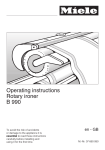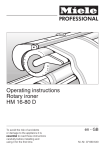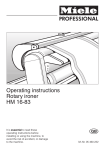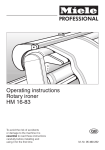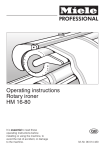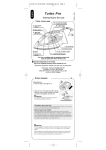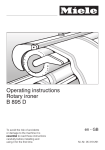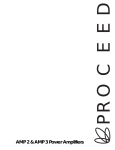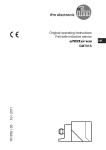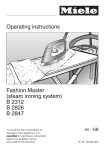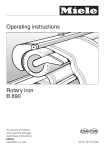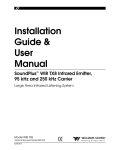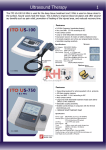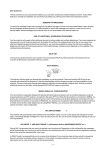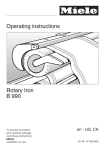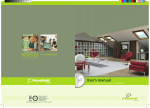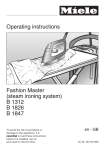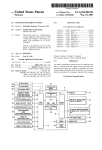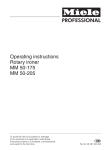Download User manual - Miele Professional Australia
Transcript
Operating instructions Rotary ironer HM 16-83 To avoid the risk of accidents or damage to the appliance it is essential to read these instructions carefully before installing and using it for the first time. en - GB M.-Nr. 07 660 590 Contents Guide to the appliance . . . . . . . . . . . . . . . . . . . . . . . . . . . . . . . . . . . . . . . . . . . . . 3 Warning and safety instructions . . . . . . . . . . . . . . . . . . . . . . . . . . . . . . . . . . . . . 5 Caring for the environment . . . . . . . . . . . . . . . . . . . . . . . . . . . . . . . . . . . . . . . . . . 8 Moving the ironer . . . . . . . . . . . . . . . . . . . . . . . . . . . . . . . . . . . . . . . . . . . . . . . . . . 9 Preparing the working area . . . . . . . . . . . . . . . . . . . . . . . . . . . . . . . . . . . . . . . . . . . 9 Before using for the first time. . . . . . . . . . . . . . . . . . . . . . . . . . . . . . . . . . . . . . . 10 Dust cover . . . . . . . . . . . . . . . . . . . . . . . . . . . . . . . . . . . . . . . . . . . . . . . . . . . . . . . 10 Before ironing . . . . . . . . . . . . . . . . . . . . . . . . . . . . . . . . . . . . . . . . . . . . . . . . . . . 11 Preparing the laundry . . . . . . . . . . . . . . . . . . . . . . . . . . . . . . . . . . . . . . . . . . . . . . 11 More advice on correct dampness. . . . . . . . . . . . . . . . . . . . . . . . . . . . . . . . . . 11 Pulling into shape and smoothing out . . . . . . . . . . . . . . . . . . . . . . . . . . . . . . . 11 Sorting. . . . . . . . . . . . . . . . . . . . . . . . . . . . . . . . . . . . . . . . . . . . . . . . . . . . . . . . 11 Check that the finger guard is functioning properly. . . . . . . . . . . . . . . . . . . . . . . . 12 Ironing . . . . . . . . . . . . . . . . . . . . . . . . . . . . . . . . . . . . . . . . . . . . . . . . . . . . . . . . . . 13 Switching on and off . . . . . . . . . . . . . . . . . . . . . . . . . . . . . . . . . . . . . . . . . . . . . 13 Select the temperature for ironing . . . . . . . . . . . . . . . . . . . . . . . . . . . . . . . . . . 13 Select the roller speed . . . . . . . . . . . . . . . . . . . . . . . . . . . . . . . . . . . . . . . . . . . 14 Feeding laundry in . . . . . . . . . . . . . . . . . . . . . . . . . . . . . . . . . . . . . . . . . . . . . . . . . 15 Hanging bar . . . . . . . . . . . . . . . . . . . . . . . . . . . . . . . . . . . . . . . . . . . . . . . . . . . 15 After ironing . . . . . . . . . . . . . . . . . . . . . . . . . . . . . . . . . . . . . . . . . . . . . . . . . . . . . . 16 Power cut . . . . . . . . . . . . . . . . . . . . . . . . . . . . . . . . . . . . . . . . . . . . . . . . . . . . . . . . 16 Ironing tips . . . . . . . . . . . . . . . . . . . . . . . . . . . . . . . . . . . . . . . . . . . . . . . . . . . . . . 17 Tea towels, hand towels, handkerchiefs, serviettes etc. . . . . . . . . . . . . . . . . . 17 Table cloths . . . . . . . . . . . . . . . . . . . . . . . . . . . . . . . . . . . . . . . . . . . . . . . . . . . 17 Duvet covers. . . . . . . . . . . . . . . . . . . . . . . . . . . . . . . . . . . . . . . . . . . . . . . . . . . 18 Maintenance and care . . . . . . . . . . . . . . . . . . . . . . . . . . . . . . . . . . . . . . . . . . . . . 19 Cleaning the heater plate . . . . . . . . . . . . . . . . . . . . . . . . . . . . . . . . . . . . . . . . . . . 19 Cleaning the casing . . . . . . . . . . . . . . . . . . . . . . . . . . . . . . . . . . . . . . . . . . . . . . . . 19 Ironing cover . . . . . . . . . . . . . . . . . . . . . . . . . . . . . . . . . . . . . . . . . . . . . . . . . . . . . 19 Replacing the ironing cover . . . . . . . . . . . . . . . . . . . . . . . . . . . . . . . . . . . . . . . 19 Problem solving guide . . . . . . . . . . . . . . . . . . . . . . . . . . . . . . . . . . . . . . . . . . . . 23 After sales service . . . . . . . . . . . . . . . . . . . . . . . . . . . . . . . . . . . . . . . . . . . . . . . . 24 Electrical connection . . . . . . . . . . . . . . . . . . . . . . . . . . . . . . . . . . . . . . . . . . . . . . 25 Electrical connection U.K. . . . . . . . . . . . . . . . . . . . . . . . . . . . . . . . . . . . . . . . . . . . 25 Technical data . . . . . . . . . . . . . . . . . . . . . . . . . . . . . . . . . . . . . . . . . . . . . . . . . . . 26 2 Guide to the appliance a k b j i c h g f d e a Temperature selector g Hanging bar b Emergency release h Feed-in table c Controls i Roller d Mains connection cable j Heater plate e Foot pedal switch k Finger guard f Ironing table 3 Guide to the appliance Control panel a b d c a Roller speed selector c "On-Off" button I-0 b "On-Off" I-0 indicator light d oC "Temperature" indicator light 4 Warning and safety instructions Technical and electrical safety To avoid the risk of accidents and damage to the ironer please read these instructions carefully before using it for the first time. They contain important information on its safety, use and maintenance. ~ Before setting up the ironer, check it Keep these instructions in a safe place and ensure that new users are familiar with the content. Pass them on to any future owner. ~ If the supply cord is damaged, it Correct application ~ This ironer must only be used for ironing articles which were washed in water and which have a care label stating that the article is suitable for machine ironing. ~ This ironer is not intended for use by persons (including children) with reduced physical, sensory or mental capabilities, or lack of experience or knowledge, unless they are supervised whilst using it or have been shown how to use it correctly by a person responsible for their safety. for any externally visible damage. Under no circumstances should you use it if it has been damaged. A damaged appliance may be dangerous. must be replaced by a Miele approved service technician to avoid a hazard. ~ Before connecting the ironer, ensure that the connection data on the data plate (fuse rating, voltage and connected load) match the mains electricity supply. If in any doubt, consult a qualified electrician. ~ The electrical safety of this appliance can only be guaranteed when continuity is complete between it and an effective earthing system which complies with current local and national safety regulations. It is most important that this basic safety requirement is present and regularly tested, and where there is any doubt the household wiring system should be inspected by a qualified electrician. The manufacturer cannot be held liable for damage or injury caused by an inadequate earthing system (e.g. electric shock). ~ Do not connect the ironer to the mains electricity supply by a multi-socket unit or an extension lead. These do not guarantee the required safety of the appliance (e.g. danger of overheating). 5 Warning and safety instructions ~ This ironer complies with all relevant local and national safety requirements. Unauthorised repairs could result in unforeseen dangers for the user, for which Miele cannot accept liability. Repairs should only be undertaken by a Miele approved service technician. Ensure current is not supplied to the ironer until after maintenance or repair work has been carried out. ~ Faulty components must only be replaced by genuine Miele original parts. The manufacturer can only guarantee the safety of the appliance when Miele replacement parts are used. ~ The ironer is only completely isolated from the electricity supply when: – it is switched off at the wall socket and the plug is withdrawn, or Correct use ~ When working with the ironer always wear close fitting clothes. Wide sleeves, apron straps, scarves and ties etc. could be taken in by the roller. ~ Remove any rings, bracelets, or other jewellery before starting to work. Tie back long hair. ~ When heated up there is an acute risk of burning: – if the heater plate is touched, – if the foot pedal is pressed down while fingers or hands are positioned between the raised heater plate and the roller. ~ This ironer is not a toy! To avoid the risk of injury do not let children play on or near it, or with the controls. Supervise children whilst you are using it. – it is switched off at the mains, or ~ Do not drape laundry over the heater – the screw-out fuse is removed (in countries where this is applicable). ~ Use the swing out bar. ~ Do not damage, remove or bypass the safety features, fixtures and control elements of this appliance. ~ Any removable outer panels must be back in place, and all moving or electrical parts shielded before it is switched on. ~ This ironer may only be used in mobile installations such as ships if a risk assessment of the installation has been carried out by a suitably qualified engineer. 6 plate when it is heated up. Fire hazard. It is designed for hanging laundry on. After use it should be swung back out of the way. Take care not to press down on the bar when it is swung out. There is a danger that this could tip the ironer over. ~ Switch the ironer off before removing the plug from the socket. ~ Do not pull it by the cable. ~ Do not lay the connection cable over the heater plate when it is heated up. This could damage the cable - danger of electric shock. Use the cable holders on the ironer to wind the cable away. Warning and safety instructions Using accessories ~ Accessory parts may only be fitted when expressly approved by Miele. If spare parts or accessories from other manufacturers are used, this will invalidate the guarantee, and Miele cannot accept liability. ~ In countries where there are areas which may be subject to infestation by cockroaches or other vermin, pay particular attention to keeping the appliance and its surroundings in a clean condition at all times. Any damage which may be caused by cockroaches or other vermin will not be covered by the guarantee. The manufacturer cannot be held liable for damage caused by non-compliance with these Warning and Safety instructions. 7 Caring for the environment Disposal of the packing material Disposal of your old appliance or machine The transport and protective packing has been selected from materials which are environmentally friendly for disposal and can normally be recycled. Rather than just throwing these materials away, please ensure they are recycled. Ensure that any plastic wrappings, bags etc. are disposed of safely and kept out of the reach of babies and young children. Danger of suffocation! Electrical and electronic appliances / machines often contain materials which, if handled or disposed of incorrectly, could be potentially hazardous to human health and to the environment. They are, however, essential for the correct functioning of your appliance or machine. Please do not therefore dispose of it with your household waste. Please dispose of it at your local community waste collection / recycling centre or contact your Dealer for advice. Ensure that it presents no danger to children while being stored for disposal. It should be unplugged or disconnected from the mains electricity supply by a competent person. 8 Moving the ironer The ironer is fitted with four rollers. Preparing the working area ^ Hold the ironer by the ironing table to push it or to pull it towards you. You will need a height adjustable chair and a flat surface for the ironed laundry. To overcome obstacles such as carpet edges and doorways, but also to steer it: ^ Tilt is slightly. Make sure the ironer is level and secure to prevent it rolling away from you. Place close at hand: – a basket with the laundry ready for ironing to the left of the rotary ironer, – a surface for the ironed laundry to the right of the ironer. Shirts, overally and blouses etc., should be hung on coathangers immediately after ironing. Small items can be hung over the swing out bar. Keep a spray bottle of water handy for redamping laundry if necessary. 9 Before using for the first time Connection cable Dust cover The mains connection cable is wound round a hook underneath the ironing table. The dust cover which protects the roller during transit has to be removed. To remove the dust cover: Insert the plug in the socket and switch the ironer on. The heater plate will rise automatically. Now tear the dust cover and remove it. ^ Unwind the cable. Do not insert the plug into the electrical socket yet. ^ An adhesive label for the temperature selector (see illustration) is supplied separately. Please stick this around the temperature selector. 10 Before ironing Preparing the laundry Correct preparation of the laundry is essential for successful ironing. Before ironing the laundry should be: – suitably damp for ironing – pulled into shape and smoothed out – sorted Pulling into shape and smoothing out Pull damp laundry into shape as usual. Smooth out ties, straps, seams and hems. Large items such as table cloths, bed linen etc. should be folded lengthways into a number of pleats so that they can be ironed as easily as possible. Residual moisture The laundry needs to be sufficiently damp, so that when it is passed just once through the rotary ironer at the correct temperature, it will come out smooth and dry. More advice on correct dampness Material Silk Dampness for ironing wrap in a damp cloth to avoid water marks slightly damp to dry Synthetics e.g. dralon, nylon, polyester etc. Sorting Sort the laundry according to how much heat is required for ironing. First iron synthetic fibres such as nylon, polyester and artificial silk which only require a low temperature. Then iron silk, wool, cotton and linen at increasing temperatures. Iron starched items last of all to avoid any starch deposits from affecting the finish of other items. Wool press under a damp cloth (e.g. trousers) Cottons Linen slightly damp quite damp 11 Before ironing Check that the finger guard is functioning properly. The finger guard is a safety feature and should always be checked before using the ironer. ^ With the ironer switched on, press the foot pedal right down. The heater plate will lower itself onto the rotating roller. ^ If you now lift the finger guard, the roller will stop rotating and the heater plate will rise up away from the roller. ^ Let go of the finger guard and take your foot off the foot pedal. ^ Press the foot pedal right down again. The heater plate will lower itself onto the rotating roller. 12 Ironing Switching on and off Material Dot symbol Temperature range Minimum iron / Synthetics ß Low temperature Woollens / Silks ßß Medium temperature Linen / Cottons ßßß High temperature I 40 - 60°C The I-0 "On-Off" button is used for switching the ironer on and off. To switch on ^ Press the I-0 button in – The indicator light beside the button will come on. To switch off ^ Press and release the I-0 button – The indicator light beside the button will go out. Select the temperature for ironing The temperature selector is used for setting the ironing temperature. The temperature settings are indicated by dots around the selector. These dots correspond to the international symbols for ironing. An adhesive label is supplied with the appliance for the temperature selector. ^ Turn the temperature selector to the temperature you wish to use. – The oC "Temperature" indicator light will come on whilst the heater plate is heating up. It will go out when the required temperature has been reached. With mixed fibre textiles the temperature should be set to suit the most heat sensitive fibre in the fabric. For example an item made from poly-cotton should be ironed using the ßß Woollens / Silks setting and not the one for Cottons. 13 Ironing Select the roller speed Ironing There are 5 roller speed settings, from low (approx. 2 m/min) to high (approx. 4.5 m/min). The ironing process is controlled by the foot pedal which has three positions: A low speed makes it easier to iron complicated articles such as shirts and blouses. A lower speed should also be selected for folded items. Thinner, single thickness items, e.g. tea towels can be ironed at a higher speed. – raised (rest position) – pressing – ironing To iron: ^ Press the foot pedal right down. ^ Set the roller speed selector to the speed you require. ,Do not reach between the heater plate and the rotating roller. Danger of burning and squashing your fingers. To press: ^ Press the foot pedal right down; then raise your foot slightly. The roller will stop turning and the heater plate will remain in contact with the laundry. To raise the heater plate: ^ Take your foot off the pedal. 14 Ironing Feeding laundry in Useful tips ^ Arrange laundry along the feed-in table so that it is straight and smooth. If creases appear on items being ironed: Stop the roller and pull the item back slightly. Smooth it out and if necessary dampen it with a wet cloth. Try to use the full width of the roller to help the roller cover maintain its shape. For small items, e.g. handkerchiefs, alternate between using the right and left hand sides of the roller. Items with raised buttons should be ironed face down on to the roller so that they are pressed into the cushioned surface. ^ Then carefully turn the roller by hand until the laundry makes contact with the heater plate (keep your fingers away from the heater plate). ^ Press the foot pedal down. Hanging bar A cloth should be placed over zips, metal buttons and hooks to protect the heater plate during ironing. To protect the heater plate do not iron very bulky or heat-sensitive buttons. When you have nearly finished ironing, you can set the temperature selector to l and continue ironing small items at a low temperature. Ironed laundry can be hung over the swing out bar to avoid creasing. ,Take care not to press down on the bar when it is swung out. There is a danger that this could tip the ironer over. 15 Ironing After ironing ^ Switch the ironer off. ^ Set the temperature selector to I. ^ Disconnect the appliance from the electricity supply by switching off at the socket and withdrawing the plug. If the ironer is to be put away: Power cut In the event of a power cut activate the emergency release. If there is a power cut whilst you are ironing the heater plate will stay in contact with the roller. This traps the laundry with the danger of it singeing. To free the laundry: ^ Allow the heater plate to cool down. ^ Wind up the mains cable. ^ Cover the ironer. ^ Pull the emergency release catch upwards. – This releases the pressure and the laundry can be removed. When power is restored (the On-Off indicator light will come on) press the emergency release catch back down. You can now continue ironing. 16 Ironing tips The following tips are intended as helpful suggestions to get you started. With practice you will probably find alternative ways of ironing which suit your style of working. Tea towels, hand towels, handkerchiefs, serviettes etc. Place on the ironing table with the straight grain of the fabric towards the feed board. This will prevent the item going out of shape and it will be easier to fold. Handkerchiefs and serviettes can be fed into the ironer horizontally and then folded and ironed again if wished. Use the full width of the roller. ^ Then pass both sides of the un-ironed sections through the ironer. Table cloths Sheets To avoid creases iron the middle section first. Sheets can be ironed in the same way as table cloths, or if a lengthwise fold is acceptable they can be folded and ironed. Leave the ironed middle section hanging over the left hand side of the roller to prevent creases. Embroidered sections and raised patterms on linen should be ironed on the right side first and then from the reverse. ^ Place the table cloth across the roller with the ends hanging off either end. ^ Then fold in half. 17 Ironing tips Duvet covers Pillow cases ^ First do up poppers and buttons and feed this end through the ironer first. Then iron the whole pillow case from both sides. ^ First do up poppers and buttons. Feed this end through the left hand side of the ironer first. Buttons should face into the roller. ^ Iron duvets in two runs lengthwise. 18 Maintenance and care ,Disconnect the ironer from the electricity supply by switching off at the wall socket and withdrawing the plug before any cleaning and maintenance work. Cleaning the heater plate Limescale deposits and starch residues can be removed from the heater plate using a suitable proprietary cleaning agent. Make sure that the ironer is cold before cleaning it. Ironing cover The ironing cover is made from aramid needle cloth with 2% stainless steel fibre content. It is normal for the ironing cover to become slightly brown with use. If, however, the cover begins to look very unsightly, it can be replaced easily. Replacement covers are available from you Miele dealer or the Miele Spare Parts Dept. Replacing the ironing cover Do not use any abrasive cleaning agents. Cleaning the casing Depending on how dirty it is, the casing can be wiped down with a dry or a damp cloth. The ironing cover should only be changed when the appliance is cold. Remove the feed-in table. Do not use any abrasive cleaning agents. ^ First remove the feed-in table by lifting it out of the right hand holder, and then pulling it out to the left of the roller. 19 Maintenance and care ^ Undo the cords at each end of the roller cover. ^ Completely unwind the cotton undercloth attached to the roller and let it hang down smoothly. ^ Unwind the cover. ^ Take hold of the cloth by each side edge and keeping it taut place over the heater plate. The slot which holds the cotton undercloth is now at the top. 20 Maintenance and care ^ Insert the raw edge of the new ironing cloth into the retaining slot with the wrong side down. Leave the cords hanging free and smooth out the cloth. ^ Press the foot pedal and "iron" the cloth into position. Do not let the cords get under the cloth as it turns. After the roller has gone through three or four revolutions and the end of the ironing cover is under the heater plate: ^ Switch the ironer off while keeping the foot pedal pressed down. The ironing cover is held firmly in place by the heater plate which is still lowered. ^ Turn the roller by hand in the direction you iron (see arrow) until the cover retaining slot is at the bottom. ^ Switch the ironer on. When the ironer is switched on, the heater plate heats up immediately. The temperature selector must be turned to the l setting. 21 Maintenance and care ^ Tighten the cords at the left and right hand sides of the roller, tie together and tuck in. ^ Put the feed-in table back in place. ^ Switch the ironer on - the heater plate will rise up. 22 Problem solving guide With the help of the following notes, minor faults in the performance of this appliance, some of which may result from incorrect operation, can be put right without contacting the Service Department. ,Repair work to electrical appliances should only be carried out by a suitably qualified person in strict accordance with current local and national safety regulations. Repairs and other work by unqualified persons could be dangerous. The manufacturer cannot be held liable for unauthorised work. Problem The ironer will not work. Possible cause Remedy There is no power to Check whether the appliance. - the mains plug is plugged in and switched on. - the fuse or circuit breaker has tripped. Laundry does not pass The roller cover is smoothly through the dirty. roller. Wash the cover at 60°C. Remove these with household Laundry does not pass There are calcium smoothly through the deposits (from hard washing-up liquid or a suitable proprietary cleaning agent. roller. water) or starch residues on the heater plate. Folds have formed in the roller cover. The heater plate is dirty (calcium deposits). Clean the heater plate with household washing-up liquid or a suitable proprietary cleaning agent. The roller cover is very Starch deposits etc. Wash the cover at 60°C. dirty. The heater plate has no contact pressure. The emergency release catch has been pulled up. Push the emergency release catch down (see also "Power cut"). 23 After sales service Repairs In the event of any faults which you cannot remedy yourself please contact – Your Miele dealer or – the Miele Service Department (see back cover for contact details). When contacting Miele, please quote the Model and Serial number of your appliance, both of which are given on the data plate which is located at the front underneath the ironing table. a Model b Serial number c Voltage/Frequency d Fuse rating (on-site) e Connected load The wiring diagram is located at the front right hand side of the ironing table behind the plastic cover. N.B.: A call-out charge will be applied for unnecessary service visits where the problem could have been rectified as described in this instruction manual. 24 Please note that telephone calls may be monitored and recorded for training purposes. Electrical connection Electrical connection U.K. Non-rewireable plugs BS 1363 All electrical work should be carried out by a suitably qualified and competent person, in strict accordance with current national and local safety regulations (BS 7671 in the UK). The fuse cover must be refitted when changing the fuse, and if the fuse cover is lost, the plug must not be used until a suitable replacement is obtained. The colour of the correct replacement cover is that of the coloured insert in the base of the plug, or the colour that is embossed in words on the base of the plug (as applicable to the design of plug fitted). Ensure power is not supplied to the appliance until after installation work has been carried out. The appliance is supplied with a mains cable with moulded plug ready for connection to a 220-240V mains supply. Please ensure the connection data quoted on the data plate match the household mains supply. Connection should be made via a suitable switched socket which is easily accessible after installation. Replacement fuses should be ASTA approved to BS 1362 and have the correct rating. Replacement fuses and fuse covers may be purchased from your local electrical supplier. WARNING: THIS APPLIANCE MUST BE EARTHED For extra safety it is advisable to protect the appliance with a suitable residual current device (RCD). Contact a qualified electrician for advice. Do not connect via an extension lead. Extension leads do not guarantee the required safety of the appliance (e.g. danger of overheating). 25 Technical data Height 96 cm Width 105 cm Depth 38 cm Weight ca. 38 kg max. load 372 Newton Voltage see data plate Rated load see data plate Fuse rating see data plate Test certificates awarded Radio/TV suppressed, VDE Australia C-Tick Mark, acc. to AS/NZ S 1044 Noise level 53.5 dB(A) (Measured in accordance with DIN (IEC) 45 635) 26 27 Alteration rights reservedn/3009 M.-Nr. 07 660 590 / 00




























